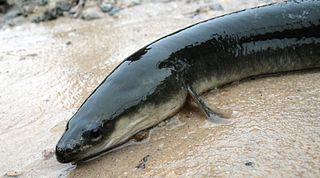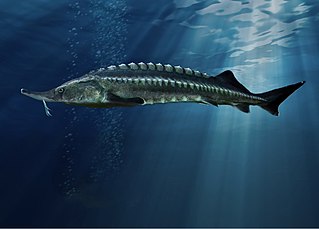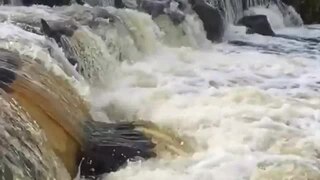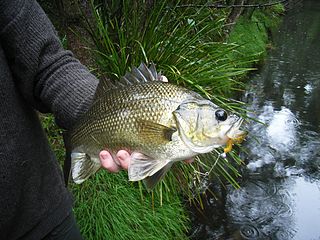Related Research Articles

Brackish water, also sometimes termed brack water, is water occurring in a natural environment having more salinity than freshwater, but not as much as seawater. It may result from mixing seawater with fresh water together, as in estuaries, or it may occur in brackish fossil aquifers. The word comes from the Middle Dutch root "brak". Certain human activities can produce brackish water, in particular civil engineering projects such as dikes and the flooding of coastal marshland to produce brackish water pools for freshwater prawn farming. Brackish water is also the primary waste product of the salinity gradient power process. Because brackish water is hostile to the growth of most terrestrial plant species, without appropriate management it is damaging to the environment.

An estuary is a partially enclosed coastal body of brackish water with one or more rivers or streams flowing into it, and with a free connection to the open sea. Estuaries form a transition zone between river environments and maritime environments and are an example of an ecotone. Estuaries are subject both to marine influences such as tides, waves, and the influx of saline water and to fluvial influences such as flows of freshwater and sediment. The mixing of seawater and freshwater provides high levels of nutrients both in the water column and in sediment, making estuaries among the most productive natural habitats in the world.

Many types of fish migrate on a regular basis, on time scales ranging from daily to annually or longer, and over distances ranging from a few metres to thousands of kilometres. Fish usually migrate to feed or to reproduce, but in other cases the reasons are unclear.

Sturgeon is the common name for the 27 species of fish belonging to the family Acipenseridae. The earliest sturgeon fossils date to the Late Cretaceous, and are descended from other, earlier acipenseriform fish who date back to the Triassic period some 245 to 208 million years ago. The family is grouped into four genera: Acipenser, Huso, Scaphirhynchus and Pseudoscaphirhynchus. Two species may be extinct in the wild, and one may be entirely extinct. Two closely related species, Polyodon spathula and Psephurus gladius are of the same order, Acipenseriformes, but are in the family Polyodontidae and are not considered to be "true" sturgeons. Both sturgeons and paddlefish have been referred to as "primitive fishes" because their morphological characteristics have remained relatively unchanged since the earliest fossil record. Sturgeons are native to subtropical, temperate and sub-Arctic rivers, lakes and coastlines of Eurasia and North America.

The American eel is a facultative catadromous fish found on the eastern coast of North America. Freshwater eels are fish belonging to the elopomorph superorder, a group of phylogenetically ancient teleosts. The American eel has a slender, snake-like body that is covered with a mucus layer, which makes the eel appear to be naked and slimy despite the presence of minute scales. A long dorsal fin runs from the middle of the back and is continuous with a similar ventral fin. Pelvic fins are absent, and relatively small pectoral fins can be found near the midline, followed by the head and gill covers. Variations exist in coloration, from olive green, brown shading to greenish-yellow and light gray or white on the belly. Eels from clear water are often lighter than those from dark, tannic acid streams.

The salmon run is the time when salmon, which have migrated from the ocean, swim to the upper reaches of rivers where they spawn on gravel beds. After spawning, all Pacific salmon and most Atlantic salmon die, and the salmon life cycle starts over again. The annual run can be a major event for grizzly bears, bald eagles and sport fishermen. Most salmon species migrate during the fall.

The Atlantic salmon is a species of ray-finned fish in the family Salmonidae. It is the 3rd largest of the Salmonidae, behind Siberian Taimen and Pacific Chinook Salmon, growing up to a meter in length. Atlantic salmon are found in the northern Atlantic Ocean and in rivers that flow into this ocean. Most populations of this fish species are anadromous, hatching in streams and rivers but moving out to sea as they grow where they mature, after which the adult fish seasonally move upstream again to spawn.

The Chinook salmon is the largest species of Pacific salmon as well as the largest in the genus Oncorhynchus. Its common name is derived from the Chinookan peoples. Other vernacular names for the species include king salmon, Quinnat salmon, Tsumen, spring salmon, chrome hog, Blackmouth, and Tyee salmon. The scientific species name is based on the Russian common name chavycha (чавыча).

The beluga, also known as the beluga sturgeon or great sturgeon, is a species of anadromous fish in the sturgeon family (Acipenseridae) of order Acipenseriformes. It is found primarily in the Caspian and Black Sea basins, and formerly in the Adriatic Sea. Based on maximum size, it is the third-most-massive living species of bony fish. Heavily fished for the female's valuable roe, known as beluga caviar, wild populations have been greatly reduced by overfishing and poaching.

Sundarbans is a mangrove area in the delta formed by the confluence of the Ganges, Brahmaputra and Meghna Rivers in the Bay of Bengal. It spans from the Hooghly River in India's state of West Bengal to the Baleswar River in Bangladesh's division of Khulna. It comprises closed and open mangrove forests, land used for agricultural purpose, mudflats and barren land, and is intersected by multiple tidal streams and channels. Four protected areas in the Sundarbans are enlisted as UNESCO World Heritage Sites, viz. Sundarbans National Park, Sundarbans West, Sundarbans South and Sundarbans East Wildlife Sanctuaries.

Sea trout is the common name usually applied to anadromous forms of brown trout, and is often referred to as Salmo trutta morpha trutta. Other names for anadromous brown trout are sewin (Wales), peel or peal, mort, finnock (Scotland), white trout (Ireland) and salmon trout (culinary). The term sea trout is also used to describe other anadromous salmonids—coho salmon, brook trout, Arctic char, cutthroat trout and Dolly Varden. Even some non-salmonid species are also commonly known as sea trout—Northern pikeminnow and members of the weakfish family (Cynoscion).

The Australian bass is a small to medium-sized, primarily freshwater species of fish found in coastal rivers and streams along the east coast of Australia. It is a member of the family Percichthyidae and the genus Macquaria. Australian bass is an important member of the native fish assemblages found in east coast river systems. It is a predatory native fish and an extremely popular angling species. The species was simply called perch in most coastal rivers where it was caught until the 1960s, when the name Australian bass started to gain popularity.

The Pansipit River is a short river located in the Batangas province of the Philippines. The river is the sole drainage outlet of Taal Lake, which empties to Balayan Bay. The river stretches some 9 kilometers (5.6 mi) passing along the municipalities of Agoncillo, Lemery, San Nicolas, and Taal, serving as a boundary between the communities. It has a very narrow entrance from Taal Lake.

Freshwater fish are those that spend some or all of their lives in fresh water, such as rivers and lakes, with a salinity of less than 1.05%. These environments differ from marine conditions in many ways, the most obvious being the difference in levels of salinity. To survive fresh water, the fish need a range of physiological adaptations.

Animal migration is the relatively long-distance movement of individual animals, usually on a seasonal basis. It is the most common form of migration in ecology. It is found in all major animal groups, including birds, mammals, fish, reptiles, amphibians, insects, and crustaceans. The trigger for the migration may be local climate, local availability of food, the season of the year or for mating reasons.

The skipjack shad is a North American, migratory, fresh- and brackish water fish species in the herring family Clupeidae. The name skipjack shad comes from the fact that it is commonly seen leaping out of the water while feeding. Other common names include blue herring, golden shad, river shad, Tennessee tarpon, and McKinley shad. The skipjack shad is restricted to the Gulf of Mexico drainage basins. Skipjack shad are found in clear to moderately turbid water in areas with flow. Because they are a migratory species, dams often impede their reproduction. Records suggest that this species was much more abundant in the Upper Mississippi River basin before it was impounded. Currently, the skipjack shad is most abundant in the Upper Mississippi River below the mouth of the Ohio River. They are known as an "early-run" species as they migrate to spawn in the early spring.

The Jullien's golden carp is a species of endangered freshwater ray-finned fish in the family Cyprinidae found in Southeast Asian river basins. Its existence is being threatened by various economic activities, such as large-scale agriculture and the building of dams for hydropower.

The giant pangasius, paroon shark, pangasid-catfish or Chao Phraya giant catfish is a species of freshwater fish in the shark catfish family (Pangasiidae) of order Siluriformes, found in the Chao Phraya and Mekong basins in Indochina. Its populations have declined drastically, mainly due to overfishing, and it is now considered Critically Endangered.

Coilia nasus, also known as ungeo and the Japanese grenadier anchovy or Chinese tapertail anchovy is a species of ray-finned fish from the family Engraulidae (anchovies). It grows to 41 cm (16 in) total length; it is a relatively large species for its genus. It is found in marine, freshwater, and brackish water at depths down to 50 m (160 ft). It is an example of an anadromous fish species, with some populations moving to freshwater to spawn. Overall they are distributed in the northwest Pacific, between 21–42°N and 109–134°E, or from Guangdong in China to the west coast of the Korean peninsula and the Ariake Sound in southwestern Japan. A traditional delicacy, the species is commercially fished in Korea, China and Japan. In China it is one of the most expensive fish sold, and as the anadromous variety is more expensive than the freshwater variety, the industry is mostly focussed in the Yellow Sea, East China Sea, and Yangtze.
The Shad Foundation is an international non-profit 501(c)(3) organization established in 1996 for the study, protection, and celebration of shads around the world. Currently, there are more than 30 recognized shad species worldwide. Shad, which are members of the herring family, are widely distributed, and many are anadromous, meaning that they migrate from fresh to salt water as juveniles and return to freshwater for the express purpose of spawning. Many species are threatened by water pollution, overfishing, habitat destruction, and obstacles to migration, such as dams.
References
- ↑ Gough, Peter; Philipsen, Peter; Schollema, Peter Paul; Wanningen, Herman (2012). From Sea to Source, International guidance for the restoration of fish migration highways. The Netherlands: Regional Water Authority Hunze en Aa's. p. 300.
- ↑ "Message from Sharon Dijksma". WFMD Youtube channel. WFMD2014.
- ↑ "Fish Passage 2015 conference". You Tube. World Fish Migration Day. Retrieved 13 October 2015.
- ↑ "World Fish Migration Day". World Gish Migration Day. WFMD2016. Retrieved 13 October 2015.
- ↑ "World Fish Migration Blog". World Fish Migration Blog. WFMD2014. Retrieved 13 October 2015.
- ↑ "Salmon spawn in upper Taff after 200 years, says river trust". BBC. BBC. 24 May 2014. Retrieved 6 October 2015.
- ↑ "The World's Largest Migratory Freshwater Fish". Water currents. National Geographic. 24 May 2014. Retrieved 6 October 2015.
- ↑ "CORRIDA MIGRAÇÃO". TV Universitaria Lavras. TV Universitaria Lavras. Retrieved 6 October 2015.
- ↑ "Zeb Hogan & World Fish Migration Day". WFMD. Fish Passage 2015 conference. 28 June 2015. Retrieved 6 October 2015.
- ↑ "World Fish Migration Day". Mulkear Life. Mulkear Life.
- ↑ "World Fish Migration day". rtv oost. 24 May 2014. Retrieved 6 October 2015.
- ↑ https://www.worldfishmigrationday.com/download.php?id=70